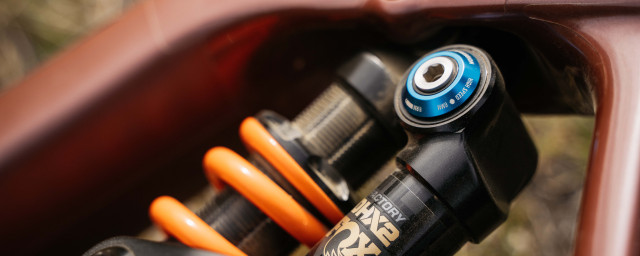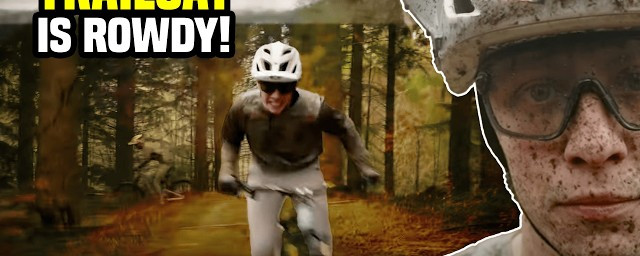If it ain’t broke don’t fix it. Thankfully Mason Cycles hasn’t when it comes to the latest Bokeh 3.0, it’s merely been tweaked, refined and enhanced to make this iteration even more capable and versatile on gravel tracks, or tackling a challenging adventure than ever before. It still has that lightweight, fun-ride nature to it, but with a bit more attitude.
- Best gravel bikes under £1,500 in 2023 - drop-bar machines that won't break the bank
- Cotic Cascade review
- Gravel bike suspension and dropper posts - do you need them?
Mason Bokeh 3 GRX - Technical details
Right, let’s get straight into what makes the Bokeh 3 different to the Bokeh 2. First up, there has been an increase in the number of mounts on offer for carrying liquid or general luggage with new ones added for bolt-on top-tube bags. There's also a mounting point on the rear of the seat tube for mudguard/fender attachment.
In addition to this, you’ll find two water bottle cage mounts in the traditional positions (although they have been positioned lower to give more clearance for big bottles and bags), plus another set under the down tube which has also been lowered to give more front tyre clearance with a bag fitted.
There are mounts for full mudguards and rack at the rear, plus there are also mounts on the fork but we’ll get to that a little later. All mounting eyelets have also been compression fitted and 3M bonded into the tubes to increase carrying capacity and to reduce possible salt, dirt and moisture ingress.
The top tube now also sees internal dynamo cable routing on its underside for a discrete look. It’s a very neat touch for an adventure-style bike, reducing a rider’s dependability on batteries.
Cable routing has also been given a tweak. The rear mech cable was originally routed down the seat stay from the port which will now be used for the dynamo cable to exit, but the brake hose now runs fully inside the frame.
The Bokeh uses Mason’s own ‘ThruBB’ bottom bracket shell which is larger than standard and allows it to run a threaded BSA bottom bracket. All of the hoses and cables thread beneath the crankset spindle without any interference or rubbing. You can even fit a dropper post cable in there.
Mason has redesigned the rear dropouts and they are now smoothly welded and blended into the frame rather than being butt-welded as seen in previous versions. These are said to reduce stress and increase durability and stiffness. The dropouts are forged and CNC-machined while the rack eyelets are now deeper and fully threaded to resist damage. I kind of like the way that the mech hanger shape where it meets the frame looks like a yawning polar bear, too – just me?
As I hinted at in the opening bit of the review, the tyre clearances have been slightly tweaked. Earlier Bokehs could take 45mm/700c and 55mm (2.1in)/650b tyres but now the stays of the frame have been tweaked for a bit more room to accommodate knobbly tyres and sticky mud.
Something that is completely new though is the fork which Mason has called the Rangefinder AS. Designed in-house from the ground up in terms of shape and carbon-fibre layup, it is developed to work with big tyres while capable of load carrying and providing a comfortable ride.
You’ll see that there are three bolts on each leg, plus you also get an internal brake hose and dynamo cable routing. Each eyelet is static tested to 30kg vertical loading, although Mason rates them to a more realistic 3kg per side to cope with fork-mounted cages and loaded bike bags, which amounts to a fair amount of kit. The bosses are also optimised for lo-rider/front-carrier mounts and rondo racks.
The flat caliper mount is designed for a 160/180mm rotor which is a step up from the 140/160mm on the previous Bokeh.
Away from all of the changes you are still getting the same Italian-manufactured bike created from that Dedacciai aluminium alloy tubing, all of which are profiled and butted in such a way to help promote a great ride quality. The manufacturing and finish quality is to an unbelievably high standard.
All of Mason’s frames and forks complete various strength and fatigue testing to meet and comply with ISO standards. Not something that is required by law for the frames to be sold but it does give you the confidence that underneath the paint is a very durable and dependable frame. Speaking of paint, the Bokeh is available in Flare Orange, Sensor Blue and this Sepia colour.
Mason offers the Bokeh 3 in a total of eight sizes from 48cm to 62cm with the two biggest sizes (60cm and 62cm) getting a larger 34.9mm diameter seat tube running a 31.6mm seatpost.
As for the geometry of the medium (54cm), the effective top tube length is 551mm with a 540mm seat tube (C-to-T) and a 145mm tall head tube. The overall wheelbase is 1,028.4mm with a 435mm rear centre measurement. The bottom bracket drop is 73mm while the fork crown height is 398mm with the fork having an offset of 50mm. Angle wise we are talking 71 degrees at the head tube and 73 degrees for the seat tube.
All of this gives stack and reach figures of 568.1mm and 376.2mm respectively.
Mason Bokeh 3 GRX - Componentry
First of all, if you aren’t after a fully built bike then Mason offers the Bokeh 3 as a frameset only at £1,450. That includes the frame, fork, headset and the seat clamp.
Kicking off the builds though is the GRX 800 11-speed mechanical offering (pictured here) which is available in either 1x (£3,280) or 2x (£3,320) set-ups. Ratio-wise, we have a 42T chainring paired with an 11-42T cassette.
Ours specifically comes with Ritchey’s VentureMax WCS Flare handlebar and Deda Superzero stem for the cockpit, with Mason’s Penta carbon seatpost which is wearing a Fizik Terra Argo saddle.
We also have a set of Mason/Hunt AdventureSport Disc wheels in a 650B size, wrapped in Schwalbe’s very capable G-One Bite at 2.1in wide. All very good kit with nothing basic chucked in to keep costs down. All of the builds are tweakable, too.
A Bokeh with Rival XPLR is £3,550, or £3,655 with Campagnolo Ekar. Above that we are back to GRX but this time it’s Di2, which’ll set you back £4,100 which is the same price as the Sram Force XPLR build.
Mason Bokeh 3 GRX - Ride impressions
This Bokeh 3 model may look aggressive with the fat rubber fitted to exploit its ever so slightly increased tyre clearances, but at its core, this is still very much a fast-rolling, nimble, manoeuvrable gravel speed machine.
Completely unloaded the Bokeh is an absolute blast if you want a hoon about in the woods searching out dry twisty singletrack or taking on your well-trodden gravel trails. There is just something about the way the geometry works that the Mason just feels right under your contact points.
It’s one of those bikes you feel a part of. It’s responsive, even to the slightest input and when it allows you to nail apex after apex in a single section of the ride it gives you the confidence to push the limit on the next one, and the next one.
The steering is point-and-shoot whether that surface is hardpacked or loose, and with so much feedback coming through from the trail surface, you always know where you are with it. Whether the tyres are sliding, digging in, catching a rock edge or root – you can literally ride the Bokeh using the Force.
But surely this bike is all about distance rather than speed?
True, the Bokeh has been ridden by many to some very impressive results in ultra-distance in the UK and all around the world and when loaded up this is a very capable bike, but it’s nice to have the option and machinery that lets you ride that little bit faster, and above all, have a bit of fun.
Now, I don’t do ultra events. I’d probably be hard-pressed to class my rides at the moment as adventures let alone epic ones but sometimes it’s nice to get out and chill.
With the expansive countryside of Wiltshire quite literally on my doorstep, I can be in the wilderness within minutes and not see another soul for a good three or so hours. With a couple of spacers switched to the underneath of the stem and a couple of bags chucked on to carry some kit and food the Bokeh 3 will quickly show you its alter ego.
With a little less urgency from my legs and a more upright position to take in the scenery, the Bokeh is a stunning place to be. The geometry that kept everything in check-up above works in a similar sort of way when you are taking things steady.
The handling is still direct and quick if you need it but there is also a balance of neutrality there that just calms things down a bit. Ideal when you are carrying weight on the front end of the bike, or the conditions are on the tricky side.
The Bokeh is just as responsive to your touch and position too, but in a different way. On unknown bits of trail, or where things have changed as the seasons have rolled from one to the other the Mason lets you pick your way through the terrain without it ever feeling a handful or twitchy.
Get through that bit and as the trail opens up again you can stamp on the pedals and let it fly. It’s a bit like a day trip with Jekyll and Hyde, but you get to choose which one you want to play with and when.
Another thing that makes the Bokeh a joy to ride on longer journeys is the comfort on offer from the frame itself.
I’ve ridden many Masons over the years, from their road models (Definition and Resolution) to the Aspect, early Bokeh and the latest Exposure and one thing that they all have is an unbelievable ride quality regardless of whether they are created from aluminium, steel or titanium alloys.
It’d be easy here to just hide behind the volume of the tyres, bung in a bit of squidge there and it’ll mask a harsh or dead feeling frame and fork. The truth of the matter is it won’t, not entirely, especially if you are looking for it, and with 75 bikes reviewed and ridden in the last year alone I believe I can find it.
The ride feel of this Dedacciai tubing is spot on with a degree of plushness about it, an underlying hint of smoothness like you get from a high-end steel frame. The fact that it has been achieved without sacrificing overall stiffness is a bonus.
Mason Bokeh 3 GRX - Verdict
An aluminium gravel bike with a mechanical groupset sitting north of three grand may seem contrary to the lightweight carbon-fibre rhetoric filling the heads of consumers but that really isn’t what the Bokeh 3 is about.
The design and thought that has gone into this bike is immense and you don’t get a product finished to this level by going to whoever can build it the cheapest.
The Bokeh 3 is a high-end product, but it’s not just there to be picked up or ogled at the café stop. This is a bike that is designed to be ridden hard and ridden far. The ride quality is exceptional, as is the geometry. Everything just works, and when you add in all those small details that have been included to make your life easier, I think the price is actually rather good.
























Add comment